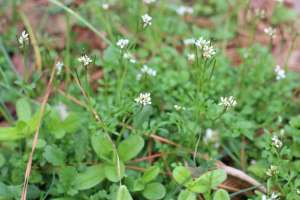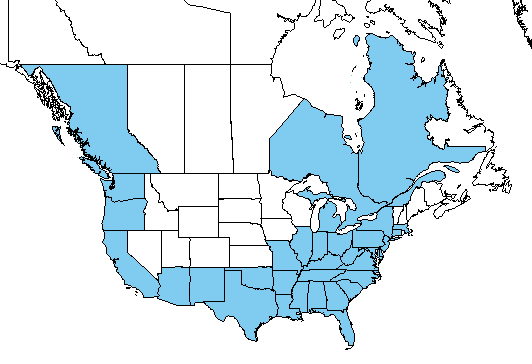Hairy bittercress (Cardamine hirsuta) is a really unfortunate name for a wonderfully tasty edible weed that is perfect for foraging.
It's a wild mustard, so its bitterness is more spicy-hot than bitter, though it's not nearly as hot as some other members of the Brassicaceae family.
The "hairy" in its name is derived from the tiny "hairs" on its leaves and stems.
The hairs are more noticeable on young Hairy bittercress, but you still have to look pretty hard, like with a loupe or magnifying glass, to see them.
A more appropriate name would be Not-so-hairy and pleasantly-mild spicycress.
Hairy bittercress is typically considered a winter annual -- it germinates in the fall and makes seeds and flowers in the spring. But it can flower much earlier in warmer climates.
I started noticing buds this year in early February in eastern North Carolina, and just a few weeks later, the plants were covered in seedpods.

Hairy bittercress basal rosette
Identification
Leaves
Hairy bittercress is one of the smaller wild mustards with compound leaves that consist of tiny leaflets growing pinnately along leaf stalks that rarely reach more than six inches or so, a single leaflet on the tip.
Its leaves emanate from a basal rosette which is more noticeable on younger plants before the larger leaves obscure its base.
The flower stalks may be green or red, and the leaves that grow from the flower stalk are shaped differently than the main plant's leaflets, being more narrow and long.
Flowers
The tiny 2 mm white flowers of hairy bittercress begin as buds with four sepals growing on a single, smooth stalk in the middle of the plant's basal rosette.
The flowers consist of four white petals in the shape of a cross, or a crucifix – a trait that gave Hairy bittercress's family the former name of Cruciferae (now Brassicaceae) and the reason plants in this family are called "cruciferous."
A single flower forms at the end of the flower stalk as Hairy bittercress first blooms.
When the flower is finished, the petals fall away leaving green seed pods.
As the seed develops, the flower stalk will continue to grow, forming new flowers arranged alternately.
The newer flowers develop toward the bottom of the stalk.

Seeds
Hairy bittercress seed pods, or siliques, eventually turn from green to brown as they dry out.
At first glance, a colony of bittercress at the seed pod stage appears to be eaten to the ground, the dry siliques reminiscent of brown stalks chewed by deer or rabbits.
As the siliques continue to dry, they eventually "explode" like touch-me-nots, releasing their seeds up to three feet or so.
Habitat
Hairy bittercress is a weed that thrives in cooler weather and dies back in late spring or summer as temperatures climb, much like chickweed, which can often be found growing nearby.
During really cold weather, it remains dormant.
In our region, Hairy bittercress seems to do well throughout the fall and winter and into early spring.
Since it occurs in the colder months, its vibrant green leaves are easy to see against the backdrop of brown and gray.
It loves wettish, disturbed soil – the kind that is common in yards and gardens.
In fact, Hairy bittercress, like so many edible weeds, is a bane to gardeners who aren't familiar with its gourmet micro-green characteristics.
In addition to your yard and garden, look for it around the margins of springs, streams, and other naturally damp and rich areas.
We have a beautiful volunteer crop of Hairy bittercress just downhill from our hose spigot, where it thrives on the steady supply of moisture.
It's really convenient to step outside and pick a few tender sprigs when we want to add a little bite to our salad.
Like its water-loving cousin watercress (or any wild edibles that grow in or near water), avoid harvesting Hairy bittercress in areas where the water may be contaminated with toxic chemicals or pathogens.
Weed control
Since Hairy bittercress tends to be invasive, it can be a problem for gardeners.
Like any invasive weed, the best way to control it in your garden is to prevent it from taking over to start with.
Pull the plants in late winter before they have a chance to go to seed to keep it from spreading relentlessly.
Hairy bittercress uses ballistic dispersal, or ballochory, to fling its seeds several feet.
Each plant has the propensity to produce 600 to 1,000 seeds per plant.
If you wait until the seedpods are ready to "explode," you risk launching a several-hundred-seed offensive against your garden for every plant you pull.
Any roots left behind can grow into new plants, so make sure you remove the entire plant.
And since it's so tasty, you might as well consider it an accidental crop and treat yourself to a salad for your trouble.
Range
Hairy bittercress occurs throughout the eastern and southern United States and along the West Coast.

Harvesting
Where Hairy bittercress is considered invasive, harvest by pulling the whole plant by its roots.
This is really easy in loose garden soil.
It's also easy to harvest by just cutting off the leaf stalks, but avoid taking the tough flower stalks and seedpods.
The delicate leaves wilt quickly so harvest only when you're ready to use.
Eating
Like all brassicas, Hairy bittercress is an excellent natural source of vitamin C.
Its flavor profile is similar to watercress but bittercress is more readily available.
It makes an excellent substitute for micro-greens.
Use Hairy bittercress as a main salad green, garnish, or in a sandwich.
The roots are also edible and can be blended with vinegar to make a sauce or dip that's similar to horseradish.
Comments
I was going to share this to our herb society's FB page, but the picture that appears with the link is of a chanterelle, not the bittercress!
Oops, sorry about that but thanks for pointing it out! It's fixed now so a picture of bittercress actually appears!